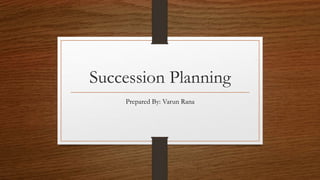Succession planning
- 1. Succession Planning Prepared By: Varun Rana
- 2. What is Succession Planning??? âĒ Succession planning is a process for identifying and developing internal people with the potential to fill key business leadership positions in the company. âĒ Succession planning increases the availability of experienced and capable employees that are prepared to assume these roles as they become available 10/12/2015Succession Planning 2
- 3. Succession Planning âĒ Ensure that employees are recruited and/or developed to fill each key role. âĒ Ensure that we operate effectively when individuals occupying critical positions depart. âĒ May be used for managerial positions or unique or hard-to fill roles. âĒ Align bench strength for replacing critical positions. 10/12/2015Succession Planning 3
- 4. What is âBench Strengthâ? âĒ An assessment of the organizationâs preparedness to replace departing staff in critical positions. âĒ Identifying people who are ready to step into someone elseâs shoes at the appropriate time under the appropriate circumstances with seamless transition. 10/12/2015Succession Planning 4
- 5. Succession Planning â What it is Not âĒ A one time event âĒ Decided by an individual âĒ Used solely for individual career advancement opportunities âĒ Reacting only when a position becomes open âĒ Line mangers relying solely on their own knowledge/comfort with candidates. 10/12/2015Succession Planning 5
- 6. Replacement vs. Succession ⊠Reactive ⊠Form of Risk Management ⊠Substituting ⊠Narrow Approach ⊠Restricted ⊠Pro-Active ⊠Planned Future Development ⊠Renewing ⊠Organized Alignment ⊠Flexible 10/12/2015Succession Planning 6
- 7. Steps in Process Identify Key/Critical Positions Conduct Position Analysis Develop Succession Plan Monitor, Evaluate, Revise 10/12/2015Succession Planning 7
- 8. Identify Key/Critical Positions âĒ Key Contributor- in achieving the organizationâs mission or would hinder vital functions âĒ Specialized Leadership â The position requires specialized or unique expertise âĒ Geographic â The position is the only one of its kind in a particular location âĒ Vacancy- Position will be vacant due to retirement/advancement in the organization/lateral moves 10/12/2015Succession Planning 8
- 9. Conduct Position Analysis âĒ What are the external and internal factors affecting this position? âĒ What competencies or skill sets will be required? âĒ What are the gaps (competencies or skill sets not possessed by the current staff)? âĒ What strategies will be used to address the gaps? 10/12/2015Succession Planning 9
- 10. Develop Succession Plan The succession plan is the culmination of Phases 1 and 2. âĒ Reviews of the individual positions and high turnover job classes are rolled into one document and gaps and strategies are formulated at an organizational or unit level. âĒ The strategies to overcome the gaps are outlined to include target completion dates, responsible parties and required resources. 10/12/2015Succession Planning 10
- 11. Monitor, Evaluate, Revise âĒ Select evaluation period-typically reviewed annually âĒ Be prepared to respond rapidly to unforseen changes to the plan âĒ Status/Progress updates should be monitored via the succession planning template and EPAâs (depends what Holly choses here) 10/12/2015Succession Planning 11
- 12. Overview of Process and Tools Process Design Org. Strategic Initiatives, Vision, Mission & Values Determine Competencies for Leadership Process Implementation Identify Key Leaders & Assess against competencies Manager & Self Evaluation Determine Gap between Actual Performance & Behaviors vs. Required Competencies Decision Making Matrix Assess Organizational Risks and Develop Strategies Executive Profiles & Organization Chart Process Management Monitor & Track Employeeâs Performance Development plans focus on both strengths And development areas 10/12/2015Succession Planning 12
- 13. What tools will we use? 10/12/2015Succession Planning 13


















